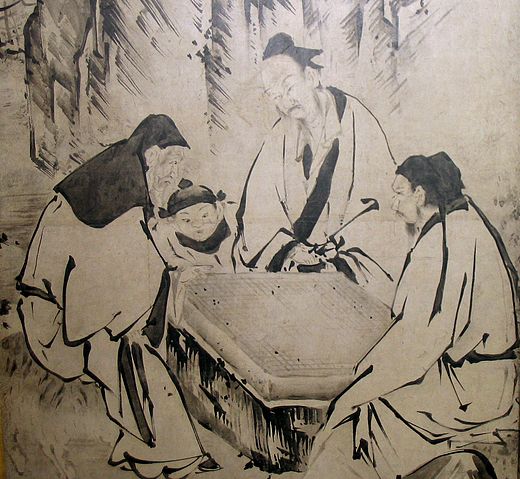 |
This is a file from the Wikimedia Commons. Information from its description page there is shown below.
Commons is a freely licensed media file repository. You can help.
|
Summary
| Description |
English: A screen painting depicting people of the Ming Dynasty playing Go, by Kanō Eitoku. (NB: The detail in this illustration comes from a pair of folding screens The Four Accomplishments that were originally attributed to Kanō Eitoku on the basis of seals that appear on each half of the pair. The screens, however, have been demonstrated by the art historian Takeda Tsuneo to be the work of Kaihō Yūshō, a painter who studied with the Kanō workshop). One of six folding screens: ink on paper. Shows people playing Go. Japan, Momoyama period, 16th century. On exhibit at the Sackler Gallery at the Smithsonian Institution.
|
| Date |
9 July 2005 |
| Source |
Photograph (by User:Quadell) of a 16th century work by en:Kaihō Yūshō in the workshop of en:Kanō Eitoku |
| Author |
User:Quadell. photo of work by Kaihō Yūshō or Kanō Eitoku |
Permission
( Reusing this file) |
see license
|
| Public domainPublic domainfalsefalse |
 |
According to Japanese Copyright Law the copyright on this work has expired and is as such public domain. According to articles 51 and 57 of the copyright laws of Japan, under the jurisdiction of the Government of Japan all non-photographic works enter the public domain 50 years after the death of the creator (there being multiple creators, the creator who dies last) or 50 years after publication for anonymous or pseudonymous authors or for works whose copyright holder is an organization.
Note: Use {{ PD-Japan-oldphoto}} for photos published before December 31, 1956.
|
|
File usage
The following pages on Schools Wikipedia link to this image (list may be incomplete):
This file contains additional information, probably added from the digital camera or scanner used to create or digitize it. If the file has been modified from its original state, some details may not fully reflect the modified file.
Schools Wikipedia was created by children's charity SOS Children's Villages. By supporting vulnerable children right through to adulthood, SOS Children makes a lasting difference to the lives of thousands of people. Education is a key part of our work, and our schools provide high-quality teaching to the children in our care. There are many ways to help with SOS Childrens Villages.




